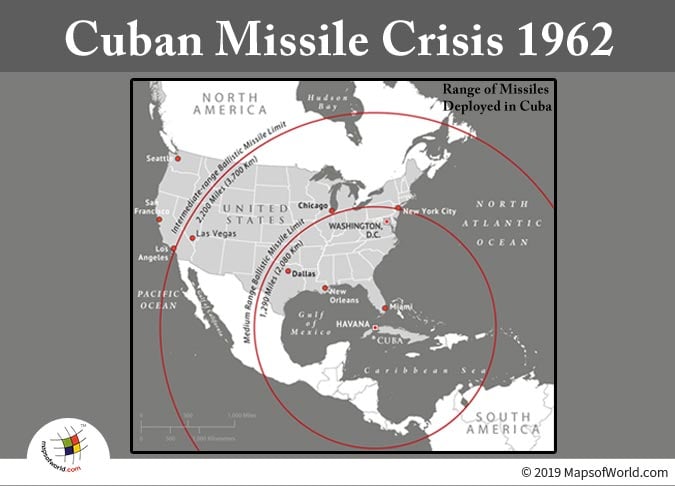

The 1962 Cuban Missile Crisis - A Confrontation Between The United States and The Soviet Union
The Cuban Missile Crisis was a confrontation between the two major superpowers – the United States and the Soviet Union. The standoff lasted for 13 days from October 16 to 28, 1962.
In 1962, tensions were running high as both the United States and the Soviet Union headed for a showdown. At the center of the conflict was the Caribbean nation of Cuba. The 13-day conflict which took place during the Cold War era had the world on its toes as a nuclear war between the two major superpowers was on cards. This could have a devastating economic effect on the world leading to millions of deaths. But, talks and negotiations between the US President John F Kennedy and the leader of the Soviet Union Nikita Khrushchev averted war.
The Soviet Union was uneasy as the United States had placed missiles in Turkey and Italy. This had put a number of Soviet cities at risk of a missile attack. The Soviets were looking to balance the equation and Cuba gave them the chance.
In 1959, Fidel Castro, who was a leftist revolutionary, seized power in Cuba and established friendly relations with the Soviet Union. The US was not happy with a communist country in its vicinity and in 1961, made an attempt to overthrow Fidel Castro by launching the Bay of Pigs invasion. Financed by the CIA, the invasion involved a 1,500 strong group of Cuban exiles who were to launch an attack into Cuba from the sea. Unfortunately for the United States, the invasions were unsuccessful and Fidel Castro fearing for the safety of his nation asked for Soviet help.
Already threatened by the US missiles in Western Europe, the Soviets responded by placing Medium Range and Intermediate-Range Ballistic missiles in Cuba with many of the American cities on their radar. The United States realized the extent of the threat on October 14, 1962. This day an American spy plane took photographs of Soviet SS-4 medium-range ballistic missile that was being assembled for installation. The US responded by establishing a naval blockade on October 22. This was to prevent the Soviets from bringing in supplies to Cuba.
The United States was at risk as the missiles were installed just 90 miles from the US state of Florida. If the Soviet Union had decided to launch the missiles, they would have hit the eastern United States within minutes. A majority of the missiles had a range of around 1,100 nautical miles which made them capable enough of hitting the capital of the United States, Washington D.C.
Meanwhile, aware of the catastrophic consequences of a nuclear war, US President Kennedy and Soviet leader Khrushchev started a series of talks. It was agreed upon that the US would promise not to invade Cuba and the Soviets in return would dismantle their missiles in Cuba. The negotiations helped avert a nuclear war that could have much wider consequences than WWII.
More than 50 years later, the world is again faced with a Cuba-like crisis. Russia is fearful that with the end of the Intermediate-Range Nuclear Forces Treaty, which was signed in 1987 to eliminate all the land based cruise missiles, ballistic missiles and missile launchers with a range between 310 and 3,420 miles, US would deploy missiles in Western Europe. Putin, the President of Russia, has given a stern warning that Russia is ready for a missile crisis similar to the one witnessed in 1962 in case the US deploys missiles.
The world is hoping the present crisis’ would also come to an end like the 1962 crisis.
Related Links:
The Republic of Madagascar is an island country located in the Indian Ocean, off the…
The Euro is the official currency of the European Union. It is, however, not incumbent…
There are many countries or regions that are partially recognized by the UN, have disputes…
The Alaska Statehood Act was signed into law by President Dwight D. Eisenhower in 1958,…
The name Persia may, however, only be used to refer to Iran in some contexts.…
Hawaii is an Island State in the US. It is one of the 50 states…